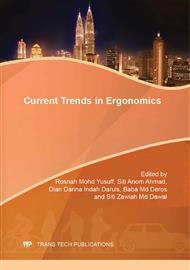[1]
J.M. Porter and D.E. Gyi, The prevalence of musculoskeletal troubles among car drivers, Occupational Medicine (Lond). 52(2002) 4 – 12.
DOI: 10.1093/occmed/52.1.4
Google Scholar
[2]
M. Massaccesi, A. Pagnotta, A. Soccetti, M. Masali, C. Masiero, F. Greco, Investigation of work related disorders in truck drivers using RULA method, Applied Ergonomics. 34 (2003) 303-307.
DOI: 10.1016/s0003-6870(03)00052-8
Google Scholar
[3]
K. Karrer, M. Roetting, Effects of Driver Fatigue Monitoring: An Expert Survey, Springer, Berlin/Heidelberg. (2007) 324–330.
Google Scholar
[4]
S.A.R. AL-Dubai, A.M. Qureshi, N.H. Ismail and K.G. Rampal, Prevalence and determinants of low back pain among taxi drivers in Malaysia: A cross sectional study, Design for Scientific Renaissance. 2(4) (2012) 129-143.
Google Scholar
[5]
A. Finneran and L. O'Sullivan, Effects of grip type and wrist posture on forearm EMG activity, endurance time and movement accuracy, International Journal of Industrial Ergonomics. 43(1) (2013) 91-99.
DOI: 10.1016/j.ergon.2012.11.012
Google Scholar
[6]
D. Barry, T. Hill and D. Im, Muscle fatigue measured with evoked muscle vibrations, Muscle nerve. 15(3) (1992) 303-309.
DOI: 10.1002/mus.880150308
Google Scholar
[7]
A. Augurelle, A.M. Smith, T. Lejeune, J. Thonnard, Importance of continuous feedback in maintaining a secure grip during manipulation of hand-held objects, J. Neurophysiol. 89 (2) (2003) 665-671.
DOI: 10.1152/jn.00249.2002
Google Scholar
[8]
M. Hagberg, B. Silverstein, R. Wells, M.J. Smith, H.W. Hendrick, P. Carayon, M. Perusse, Work Related Musculoskeletal Disorders (WMSDs): a Reference Book for Prevention, Bristol Taylor and Francis. (1995).
Google Scholar
[9]
M. Eksioglu and K. Kizilaslan, Steering Wheel grip force characteristics of drivers as a function of gender, speed, and road condition, International Journal of Industrial Ergonomics. 38(3-4) (2008) 354-361.
DOI: 10.1016/j.ergon.2008.01.004
Google Scholar
[10]
P. Gershon, D. Shinar, T. Oron-Gilad, Y. Parmet and A. Ronen, Usage and perceived effectiveness of fatigue countermeasures for professional and nonprofessional drivers, Accident, analysis and prevention. 43(3) (2011) 797-803.
DOI: 10.1016/j.aap.2010.10.027
Google Scholar
[11]
D. Clarke, P. Ward and J. Jones, Overtaking road accidents: differences in manoeuvre as a function of driver age, Accident, analysis and prevention. 30(4) (1998) 455-467.
DOI: 10.1016/s0001-4575(97)00105-x
Google Scholar
[12]
Y. Cho and Y.S. Yoon, Biomechanical model of human on seat with backrest for evaluating ride quality, International Journal of Industrial Ergonomics. (2001) 331-345.
DOI: 10.1016/s0169-8141(00)00061-5
Google Scholar
[13]
Y. Liu, and T. Wu, Fatigued driver's driving behaviour and cognitive task performance: Effect of road environments and road environment changes, Safety Science. 47(8) (2009) 1083-1089.
DOI: 10.1016/j.ssci.2008.11.009
Google Scholar
[14]
S.H. Min, S-H. Chang, S.K. Jeon, S.Z. Yoon, J.Y. Park and H.W. Shin, Posterior auricular pain caused by the trigger points in the sternocleidomastoid muscle aggravated by psychological factors, Korean J Anesthesiol. 59 (2010).
DOI: 10.4097/kjae.2010.59.s.s229
Google Scholar
[15]
Q. Li, A novel Likert scale based on fuzzy sets theory. Expert System Application, an International Journal. 40 (5) (2013) 1609-1618.
DOI: 10.1016/j.eswa.2012.09.015
Google Scholar
[16]
S.B.M. Tamrin, K. Yokoyama, J. Jalaludin, N.A. Aziz, N. Jemoin, R. Nordin, A. Li Naing, Y. Abdullah and M. Abdullah, The association between Risk Factors and Low Back Pain among Commercial Vehicle Drivers in Peninsular Malaysia: A Preliminary Result, Industrial Health. (2007).
DOI: 10.2486/indhealth.45.268
Google Scholar
[17]
V. Kaushik and N. Charpe, Effect of body posture on stress experienced by worker, Stud Home Comm Sci., 2(1) (2008) 1-5.
Google Scholar


